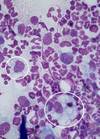Practical information Flashcards
(14 cards)
What inflammatory cell is this?

- Neutrophils
- Multi-lobed nuclei
- Are granulocytes but intracytoplasmic granules do not stain prominently –> virtually clear cytoplasm
- Nuclei lose lobulation and swell as they degenerate
- Usually associated with infection/foreign body reaction (occasionally sterile inflammation)
What inflammatory cell is this?

Eosinophils
- Granulocytes – intracytoplasmic granules take up eosin in stain –> pink/orange granules
- Often associated with mast cells and occur most commonly with Hypersensitivities
- flea, atopy, food, insects
- Ectoparasites
- Occasionally
- mast cell tumours
- pemphigus foliaceus
- superficial viral infection in cats
- In cat can indicate presence of eosinophilic granuloma complex (EGC)
What inflammatory cell is this?

Macrophages
- Medium-sized round cells (larger than neutrophils)
- Nucleus oval/indented
- Moderate amounts of cytoplasm, often vacuolated
- Multinucleate cells = inflammatory giant cells:
- small numbers seen with inflammatory cells in granulomatous reaction (esp fungal infection and foreign body reactions)
What inflammatory cell is this?

Lymphocytes
- Rounded nucleus (similar size to rbc)
- Scant basophilic cytoplasm
- Smaller than neutrophils
- If multiple larger cells, consider lymphoma
What kind of inflammatory cell is this?

Plasma cells
- Round eccentric nucleus
- Basophilic cytoplasm with clear area adjacent to nucleus
What can the relative numbers of inflammatory cells tell us?
- >70% granulocytes –> acute inflammation
- >50% monocytes –> chronic inflammation
- (often also neutrophils, lymphocytes, plasma cells)
- Mixture of neutrophils and macrophages = pyogranulomatous inflammation
What is this?

Acantholytic keratinocytes
- Large oval to round cells with round nucleus (‘fried eggs’)
- Formed when keratinocytes lose cohesion with each other and float freely in the resultant cleft, vesicle or bulla. Usually surrounded by much smaller neutrophils
- May form ‘rafts’
- Significance?
- May occur in pustules or under crusts in pemphigus foliaceus – really useful pointer to this condition!
- Also occasionally in some bacterial, fungal and viral conditions
What is this?

Neutrophils, rods, nuclear streaming
What do cheyletiella feed on?
Tissue fluid. Cheyletiella have blade like chelicerae which pierce the skin. This is important in deciding treatment.
How would you treat cheyletiella infestation in a rabbit?
- Topical or systemic products have been used on the rabbit
- Ivermectin 200µg/kg SC every 14d
- Selamectin spot-on or Lime-sulphur dip
- Environmental control is important as can survive off the host for some time
- FIPRONIL is contraindicated in rabbits
- Cheyletiella infestation is a secondary effect. Rabbits usually have a primary disease such as dental or respiraotory disease and then get cheyletiella mites
What are the three main groups of causes of pruritus?
Ectoparasites
Infections
Allergic skin diseases
Is the Sheep ked, Melophagus ovinus dangerous to the owner’s sheep?

- Sheep keds are commonly found around the rib area. They are blood feeders and do cause disease.
- Infestation results in making the sheep restless resulting in a loss of condition Severe infestations are more common in the autumn and winter and cause:
- Pruritus (direct irritancy and hypersensitivity)
- Wool loss (alopecia) and wool staining
- Skin changes (lichenification)
- Anaemia in heavy infestations, especially lambs, resulting in stunting
What are the two most common mites in poultry, and how would you differentiate between them?
Dermanyssus gallinae (red mite) & Ornithonyssus sylviarum (northern fowl mite)
Northern fowl mites are found on the body of affected chickens, red mites feed and the return to the environment and not found unless eaten by the bird


